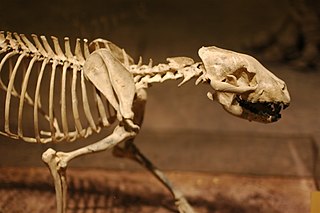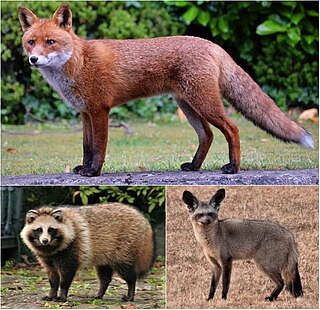
Canidae is a biological family of dog-like carnivorans, colloquially referred to as dogs, and constitutes a clade. A member of this family is also called a canid. The family includes three subfamilies: the Caninae, and the extinct Borophaginae and Hesperocyoninae. The Caninae are known as canines, and include domestic dogs, wolves, coyotes, foxes, jackals and other species.

Dusicyon is an extinct genus of South American canids.

Canis is a genus of the Caninae which includes multiple extant species, such as wolves, dogs, coyotes, and golden jackals. Species of this genus are distinguished by their moderate to large size, their massive, well-developed skulls and dentition, long legs, and comparatively short ears and tails.

The South American foxes (Lycalopex), commonly called raposa in Portuguese, or zorro in Spanish, are a genus from South America of the subfamily Caninae. Despite their name, they are not true foxes, but are a unique canid genus more closely related to wolves and jackals than to true foxes; some of them resemble foxes due to convergent evolution. The South American gray fox, Lycalopex griseus, is the most common species, and is known for its large ears and a highly marketable, russet-fringed pelt.

The crab-eating fox, also known as the forest fox, wood fox, bushdog or maikong, is an extant species of medium-sized canid endemic to the central part of South America since at least the Pleistocene epoch. Like South American foxes, which are in the genus Lycalopex, it is not closely related to true foxes. Cerdocyon comes from the Greek words kerdo and kyon (dog) referring to the dog- and fox-like characteristics of this animal.

The extinct Borophaginae form one of three subfamilies found within the canid family. The other two canid subfamilies are the extinct Hesperocyoninae and extant Caninae. Borophaginae, called "bone-crushing dogs", were endemic to North America during the Oligocene to Pliocene and lived roughly 34—2.5 million years ago, existing for about 33.5 million years.

Hesperocyon is an extinct genus of canids that was endemic to North America, ranging from southern Canada to Colorado. It appeared during the Uintan age, –Bridgerian age (NALMA) of the Mid-Eocene– 42.5 Ma to 31.0 Ma. (AEO). Hesperocyon existed for approximately 11.5 million years.

Vulpini is a taxonomic rank which represents the fox-like tribe of the subfamily Caninae, and is sister to the dog-like tribe Canini.

Caninae is the only living subfamily within Canidae, alongside the extinct Borophaginae and Hesperocyoninae. They first appeared in North America, during the Oligocene around 35 million years ago, subsequently spreading to Asia and elsewhere in the Old World at the end of the Miocene, some 7 million to 8 million years ago.

The extinct Hesperocyoninae are one of three subfamilies found within the canid family. The other two canid subfamilies are the extinct Borophaginae and extant Caninae.
Nothocyon is an extinct genus of carnivoran in the family Subparictidae which inhabited North America during the late Oligocene. At one time, many species of the dog family Canidae were placed in Nothocyon, but new fossils showed that the type species of Nothocyon, N. geismarianus, is more closely related to bears. The other species have been reassigned to other genera such as Cormocyon.

Xenocyon is an extinct group of canids, either considered a distinct genus or a subgenus of Canis. The group includes Canis (Xenocyon) africanus, Canis (Xenocyon) antonii and Canis (Xenocyon) falconeri that gave rise to Canis (Xenocyon) lycanoides. The hypercarnivorous Xenocyon is thought to be closely related and possibly ancestral to modern dhole and the African wild dog, as well as the insular Sardinian dhole.

Canis edwardii, also known as Edward's wolf, is an extinct species of wolf in the genus Canis which was endemic to North America three million years ago from the Late Blancan stage of the Pliocene epoch and was extinct by the end of the Irvingtonian stage of the Pleistocene epoch.

Canis lepophagus is an extinct species of canid which was endemic to much of North America during the Early Pliocene. It is notable because its lineage is proposed to have led to both wolves and coyotes.

Eucyon is an extinct genus of medium omnivorous coyote-like canid that first appeared in the Western United States during the late Middle Miocene 10 million years ago. It was the size of a jackal and weighed around 15kg. It was one of the few North American mammals which invaded Eurasia about 6 million years ago, followed by the genus going extinct 3 million years ago. This genus is proposed to have given rise to genus Canis 6 million years ago.
Canis nehringi is an extinct species of canid. Canis gezi, a poorly known small wolf from the Ensenadan of South America, appears to have given rise to Canis nehringi, a Lujanian species from Argentina. The species was first described by Florentino Ameghino in 1902.
Richard Hall Tedford was Curator Emeritus in the Department of Vertebrate Paleontology of the American Museum of Natural History in New York City, having been named as curator in 1969.

Canini is a taxonomic rank which represents the dog-like tribe of the subfamily Caninae, and is sister to the fox-like tribe Vulpini. The Canini came into existence 9 million years ago. This group was first represented by Eucyon, mostly by Eucyon davisi that was spread widely across North America and is basal to the other members of the tribe. Its members are informally known as true dogs.

Canina is a taxonomic rank which represents the wolf-like subtribe of the tribe Canini, and is sister to the subtribe Cerdocyonina. Fossils of this group date to 5 million years ago; however, they are likely to have been in existence 9 million years ago. Its members as a group are colloquially known as the wolf-like canids.
















